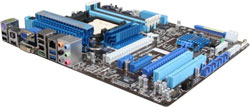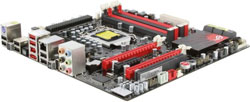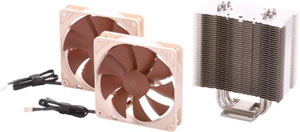Holiday 2010 System Builder's Guide
by AnandTech Staff, edited by Jarred Walton on November 19, 2010 2:00 AM EST- Posted in
- Guides
- Systems
- Holiday 2010
Raja's Midrange Overclocking Systems
What about building a bang-for-the-buck overclocking experience, you ask? As our resident overclocking guru and motherboard reviewer, Raja has more experience with this area than the rest of us so we turned this section over to him. In order to keep things simple, we kept nearly all of the components in Vivek's midrange build but switched out the motherboard, processor, RAM and PSU. We also added an aftermarket cooler to allow the CPUs to reach their full potential. Here's what Raja put together. [Ed: Text by Jarred, most of the picks by Raja.]
| Raja's Midrange AMD Overclocking System | ||
| Hardware | Component | Price |
| Processor |
AMD Phenom II X6 1055T (Thuban 45nm, 2.8 to 3.3 GHz, 6x512KB L2, 6MB L3, 125W |
$179 |
| Motherboard | ASUS M4A89GTD Pro (AMD 890GX AM3) | $135 |
| CPU Cooler | Noctua NH-U12P SE2 120mm SSO | $60 |
| Video | ASUS Radeon HD 6850 1GB (EAH6850) | $200 |
| Memory | G.Skill 2x2GB DDR3-1600 (F3-12800CL9D-4GBNQ) | $65 |
| Hard Drive | WD Caviar Blue 1TB (WD10EALS) | $70 |
| Optical Drive | ASUS 24x DVDRW (DRW-24B1ST) | $20 |
| Power Supply | Seasonic S12II 620W Bronze (80 Plus Bronze) | $75 |
| Case | Antec Nine Hundred Two | $89 |
| Total System Price | $893 | |
For AMD overclocking, I chose one of the hex-core Thuban CPUs, just so you can get every last ounce of performance out of AMD's architecture. The ASUS motherboard ended up being our top AM3 overclocking selection--at least when keeping prices in check--and is good for up to a 50% overclock by raising the base clock. Thuban will  generally top out in the 4.0-4.2GHz range, making this board a perfect fit. The Noctua cooler will help keep things cool without making a ton of noise, and the Seasonic S12II 620W power supply should deliver clean, stable current to the system.
generally top out in the 4.0-4.2GHz range, making this board a perfect fit. The Noctua cooler will help keep things cool without making a ton of noise, and the Seasonic S12II 620W power supply should deliver clean, stable current to the system.
Alternately, if you want to spin the wheel, you can also try your hand at core unlocking and save some money. $100 will buy you the Phenom II X2 560 Black Edition, which has two disabled cores. The ASUS board allows core unlocking, provided your CPU can handle it. Many users have had success with core unlocking, but there's no guarantee, and you'll never get the six cores that Thuban processors offer.
Our memory kit may not look like much, with its DDR3-1600 speed and CAS 9 timings. In reality, it shouldn't limit you but it's getting tricky to determine which memory to buy for overclocking. Vendors are now covering up their IC choices so much it's difficult to know what's inside; what we're looking for is an Elpida BBSE type variant or a similar IC from PSC. The G.Skill kit should work, but YMMV.
| Raja's Midrange Intel Overclocking System | ||
| Hardware | Component | Price |
| Processor |
Intel Core i5-760 Lynnfield 45nm (4x2.8GHz to 3.33GHz Turbo, 8MB L3, 95W) |
$200 |
| Motherboard | ASUS Maximus III GENE (Intel P55 1156) ($20 MIR) | $127 |
| CPU Cooler | Noctua NH-U12P SE2 120mm SSO | $60 |
| Video | ASUS Radeon HD 6850 1GB (EAH6850) | $200 |
| Memory | G.Skill 2x2GB DDR3-1600 (F3-12800CL9D-4GBNQ) | $65 |
| Hard Drive | WD Caviar Blue 1TB (WD10EALS) | $70 |
| Optical Drive | ASUS 24x DVDRW (DRW-24B1ST) | $20 |
| Power Supply | Seasonic S12II 620W Bronze (80 Plus Bronze) | $75 |
| Case | Antec Nine Hundred Two | $89 |
| Total System Price | $906 | |
Okay, first let's get this out of the way: Sandy Bridge is right around the corner. Think your hopped up i5-760 overclock is impressive? Imagine an unlocked Sandy Bridge chip running at 4.3-4.5GHz on air cooling. If you're into Intel overclocking, we'd really consider just waiting a bit longer right now. But, if you must buy a P55 system right now and you want a good overclock....
For the CPU, the i5-760 remains the most sensible choice. Priced at $200, you still get four cores with great overclocking potential--hitting 4.0-4.2GHz is generally common with an appropriate motherboard and cooling. The jump to i7-870 is $80 and all you really get is Hyper-Threading, since maximum  overclocking means you'll want to disable the Turbo Boost feature and most of the Lynnfield CPUs are going to top out around the same 4.2GHz. We might be swayed to make an investment in Core i7 if it weren't for Sandy Bridge; then again, there's an upside: motherboards that used to push nearly $200 have come down quite a bit and there are plenty of rebates going around right now.
overclocking means you'll want to disable the Turbo Boost feature and most of the Lynnfield CPUs are going to top out around the same 4.2GHz. We might be swayed to make an investment in Core i7 if it weren't for Sandy Bridge; then again, there's an upside: motherboards that used to push nearly $200 have come down quite a bit and there are plenty of rebates going around right now.
The motherboard is always a critical component for overclocking, and even though there are plenty of options that can do well, we wanted something more than just a decent overclock. The ASUS Maximus III GENE can easily hit BLCKs far beyond what you'll need for an i5-760, but even better is the excellent voltage regulation that will allow you to push 4GHz and higher without pumping a ton of current through your CPU. ASUS also makes overclocking very easy on the less experienced, with only minor tweaks necessary to get your system running at top speed.
Cooling for both systems comes courtesy of the Noctua NH-U12P SE2, a high quality push-pull cooler capable of keeping your CPU temperatures down without raising noise levels.  While there are decent coolers for a bit less money, we've never been disappointed by the Noctua; it works well even with hex-core processors if you move to X58, so the Lynnfield CPUs aren't going to be a problem.
While there are decent coolers for a bit less money, we've never been disappointed by the Noctua; it works well even with hex-core processors if you move to X58, so the Lynnfield CPUs aren't going to be a problem.
You'll notice that the power supply isn't the OCZ model Vivek used; instead the PSU is a higher quality Seasonic S12II capable of delivering the clean, stable power you'd want in an overclocked system. If you want to move to dual graphics cards and a heavily overclocked CPU, the 620W power supply should still keep up with everything short of the fastest GPUs. If that's what you'd like, I suggest looking at Ryan's X58 high-end SLI build.










112 Comments
View All Comments
DanNeely - Friday, November 19, 2010 - link
I've always put my faith in the low score reviews than the high ones because people are morel likely to complain about bad parts than to write good reviews. You definitely do need to read the actual reviews and filter the idiots out first though.Brian Klug - Friday, November 19, 2010 - link
I'm glad someone caught me on the Xeon coolers - I usually forget that the boxed Xeons don't come with a cooling solution up until right as I start building, then run to the store and grab something.Honestly, everyone has their own LGA 1366/Socket B choice it seems. I went with one cooler one time that was too big for my Cosmos S case (the door wouldn't close), and hesitated to recommend something given that I haven't actually *seen* the SR-2 in the flesh. I wager one of those Zalmans that's flat (with the fan normal to the motherboard) probably makes most sense/has best chances of actually fitting.
Awesome comments ;) I wish I could build that thing, honestly!
-Brian
rootheday - Friday, November 19, 2010 - link
Interesting that the Intel budget system comes out >$120 higher than the AMD system... but most of that difference because of the choice to include a discrete GPU and BluRay drive in the Intel system. If you leveled that out (and chose same power supply/case) the Apples-to-apples comparison comes out much closer - down to a $40 difference (~10%).For that difference you get a tradeoff between slightly faster 3D graphics in the AMD 4250 (but neither will do much beyond casual gaming) vs Intel CPU that is faster in the case in most workloads and signficantly lower idle power. Both can handle media and normal browsing, photo editing, email, and productivity apps with ease.
JarredWalton - Friday, November 19, 2010 - link
Which is what we say at the bottom of the Intel page:"If you like comparisons, while some of the features are clearly different (i.e. Blu-ray, case, etc.), this Intel setup checks in at $40 more than our AMD build looking just at the motherboard and processor. It's true that Intel has plenty of less expensive processors, but rather than pitting Pentium G6950 against the Athlon II X4 645 we decided to go with the more capable i3-550. AMD's budget parts easily win in multi-threaded tests, but the Core 2010 architecture does very well in other areas. In other words, neither choice is always "right" but instead you need to decide what tasks are most important for your workload."
wwswimming - Friday, November 19, 2010 - link
This system is adequate for watching the Pipe Masters.Can I have it when you're done with it ?
Conficio - Friday, November 19, 2010 - link
I'm surprised with all the dream machines, that non of you went for one of the Multi Monitor setups.What is the hold back?
I'd think that is way more attractive for home use than a 24 GB 12 core XEON system, that is waisting more than half of its power and money going unused 95% of the time in any personal home use.
Really I'd like to hear why that does not seem to be on the wish list of any of you?
bji - Friday, November 19, 2010 - link
I can't see the point of multi monitor setups except when each monitor is used as a discrete desktop with no windows split across them. Setups where games split across monitors seem like the biggest joke to me. Who wants to play a game with a grid of bezels splashed across it? I can't believe that anyone even attempts such ridiculous setups or that these are featured by graphics card makers (AMD Eyefinity).Given that, I don't see too much point in multi-monitor setups for home use, when larger LCD panels (24 inches and above) give so much desktop real estate already.
geniekid - Friday, November 19, 2010 - link
1) I would love to see Brian's dream machine built and benchmarked.2) Does the MSI 890FXA-GD70 for Alan's HTPC support Dolby Digital Live/DTS Connect? If so, I assume the intention is to use SPDIF to send the digital audio to the receiver? Otherwise I'm surprised at the lack of a sound card.
3DoubleD - Friday, November 19, 2010 - link
To answer your 2nd question. Nearly every motherboard sold today supports DD and DTS over SPDIF. Even Windows Vista/7 drivers include support for this (along with 2ch LPCM support for other Windows sounds). So if a motherboard has SPDIF support (optical or coaxial), you have DD and DTS bit-streaming support guaranteed.ajlueke - Friday, November 19, 2010 - link
in response to 2). The idea as far as sound goes is to used the HDMI connection from the 5870 for sound. The AMD graphics cards have on board sound, as well as support for DTS-Master and TrueHD bitstreaming, no seperate soundcard required. I have found that multichannel support over the ATI cards for games is also very good, really makes Starcraft II come alive.